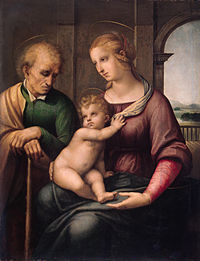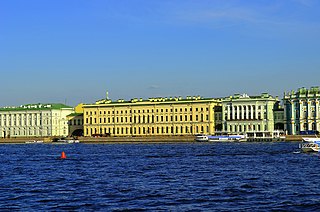
The State Hermitage Museum is a museum of art and culture in Saint Petersburg, Russia. It is the largest art museum in the world by gallery space. It was founded in 1764 when Empress Catherine the Great acquired an impressive collection of paintings from the Berlin merchant Johann Ernst Gotzkowsky. The museum celebrates the anniversary of its founding each year on 7 December, Saint Catherine's Day. It has been open to the public since 1852. The Art Newspaper ranked the museum 6th in their list of the most visited art museums, with 1,649,443 visitors in 2021.
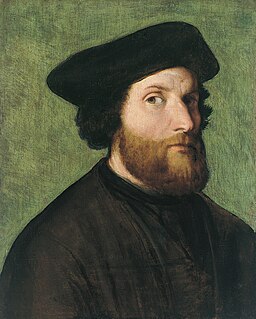
Lorenzo Lotto was an Italian painter, draughtsman, and illustrator, traditionally placed in the Venetian school, though much of his career was spent in other north Italian cities. He painted mainly altarpieces, religious subjects and portraits. He was active during the High Renaissance and the first half of the Mannerist period, but his work maintained a generally similar High Renaissance style throughout his career, although his nervous and eccentric posings and distortions represented a transitional stage to the Florentine and Roman Mannerists.

Francesco Francia, whose real name was Francesco Raibolini was an Italian painter, goldsmith, and medallist from Bologna, who was also director of the city mint.
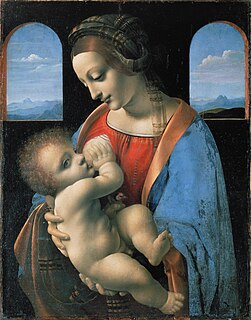
The Madonna Litta is a late 15th-century painting, traditionally attributed to Leonardo da Vinci, in the Hermitage Museum, Saint Petersburg. It depicts the Virgin Mary breastfeeding the Christ child, a devotional subject known as the Madonna lactans. The figures are set in a dark interior with two arched openings, as in Leonardo's earlier Madonna of the Carnation, and a mountainous landscape in aerial perspective can be seen beyond. In his left hand Christ holds a goldfinch, which is symbolic of his future Passion.

The Madonna of the Pinks is an early devotional painting usually attributed to Italian Renaissance master Raphael. It is painted in oils on fruitwood and now hangs in the National Gallery, London.

The Alba Madonna is a tondo (circular) oil on wood transferred to canvas painting by the Italian High Renaissance artist Raphael, created c. 1511, depicting Mary, Jesus, and John the Baptist in a typical Italian countryside.

The Soviet sale of Hermitage paintings in 1930 and 1931 resulted in the departure of some of the most valuable paintings from the collection of the State Hermitage Museum in Leningrad to Western museums. Several of the paintings had been in the Hermitage Collection since its creation by Empress Catherine the Great. About 250 paintings were sold, including masterpieces by Jan van Eyck, Titian, Rembrandt, Rubens, Raphael, and other important artists. Andrew Mellon donated the twenty-one paintings he purchased from the Hermitage to the United States government in 1937, which became the nucleus of the National Gallery of Art in Washington, D.C.

The Portrait of Andrea Navagero e Agostino Beazzano is a painting by the Italian High Renaissance painter Raphael, created in 1516. It is housed in the Galleria Doria Pamphilj, Rome.

The Madonna with Child, St. John and a Child Saint is an oil on wood painting by the Italian Renaissance artist Raphael, who executed it around 1504–1505. It is also known as Madonna Terranuova as it belonged to the Italian Dukes of Terranuova, from whom it went to Berlin's Staatliche Museen, where it has been since 1854.
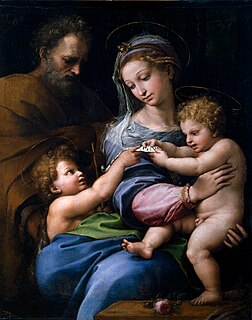
The Madonna of the Rose is a 1518-1520 painting, now in the Museo del Prado in Madrid. Its attribution as by Raphael is uncertain, and the involvement of Giulio Romano cannot be excluded. The rose and the lower portion were added at a later date by an unknown artist. A second autograph version of this painting, without the added rose and lower strip, painted on wood panel, is owned by real estate magnate Luke Brugnara.In 2022 the painting was included in a exhibition held by the National Gallery

St. George and the Dragon is a small oil on wood cabinet painting by the Italian High Renaissance artist Raphael, painted c. 1505, and now in the National Gallery of Art in Washington, D.C. The saint wears the blue garter of the English Order of the Garter, reflecting the award of this decoration in 1504 to Raphael's patron Guidobaldo da Montefeltro, Duke of Urbino, by King Henry VII of England. The first word of the order's motto, "HONI" can be made out. The painting was presumably commissioned by the Duke, either to present to the English emissary who brought the regalia to Urbino, Sir Gilbert Talbot, or to Henry himself—recent scholarship suggests the latter. The honour paid to a minor Italian ruler reflected Henry's appreciation of the cultural prestige of Renaissance Italy as much as any diplomatic purpose.

The Pinacoteca Comunale ofCittà di Castello is the main museum of paintings and arts of Umbria Italian Region, alongside the Perugia's National gallery, and it's housed in a renaissance palace, generally preserved in its original form.
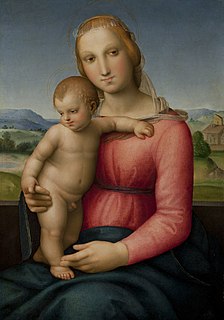
The Virgin and Child, commonly known as The Northbrook Madonna after the Northbrook Collection in England, is a painting from the early 16th century by an unknown artist possibly identified as Domenico Alfani. It is in the permanent collection of the Worcester Art Museum in Worcester, Massachusetts, United States. It was formerly attributed to Raphael, but scholars have since concluded otherwise.

Adoration of the Shepherds is the title of a lost drawing by Raphael, described in a letter of 8 September 1508, from Raphael to his friend Francesco Raibolini alias Francesco Francia. This letter's contents were first published in 1678, in Carlo Cesare Malvasia's book Felsina Pittrice. Malvasia gave a full account of the letter, which he claimed to have found among the papers of Count Antonio Lambertini in Bologna. While the existence and contents of the letter are disputed, according to Malvasia it described the delivery of a drawing of the Adoration of the Shepherds to Francesco Francia. This drawing has been considered lost or never to have existed.
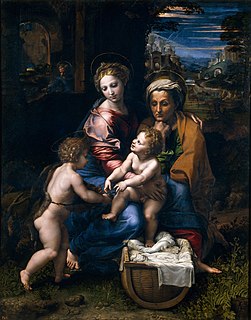
La Perla is a 1518-1520 oil on canvas painting by Raphael with the participation of Giulio Romano. Several studies revealed a very profuse underlying drawing by the last Raphael. At this stage clearly influenced by his encounter with Leonardo (1513-1516) the pyramidal arrangement of the characters, the light contrasts and the recreation of a landscape that is no longer idealized but realistic are proof of it.

The Madonna of the Baldacchino is a c.1506-1508 oil on canvas holy conversation-style painting by Raphael, now in the Galleria Palatina in Florence.
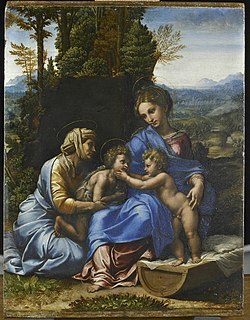
The Small Holy Family is an oil-on-panel painting by Raphael and assistants, now in the Louvre in Paris. Its name distinguishes it from his Great Holy Family, also in the Louvre. It is signed and dated "RAPHAEL VRBINAS S[anti] PINGEBAT MDXVIII" on the hem of the Madonna's garment.
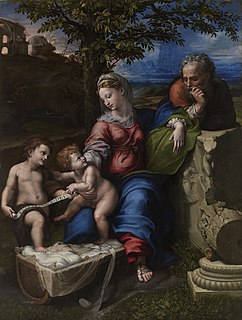
Holy Family under an Oak Tree or Madonna of the Oak Tree is an oil on panel painting by Giulio Romano using a composition or underdrawing by Raphael. It is now in the Prado in Madrid. It is dated to c. 1518 by its stylistic similarities to other works produced by the two artists around that time such as La Perla (Prado). In the background is a valley reminiscent of that of the River Tiber, with a ruin on a hill to the left based on the Basilica of Maxentius or the Baths of Caracalla.

The Diotallevi Madonna is a c.1504 oil on panel painting by Raphael, now in the Bode Museum in Berlin, which it entered in 1841-1842 from marquess Diotallevi's collection in Rimini. Previously attributed to Raphael's teacher Perugino, almost all art historians now attribute it to Raphael, with the exception of Adolfo Venturi who attributed it and parts of Perugino's Madonna della Consolazione to an anonymous "Master of the Diotallevi Madonna".
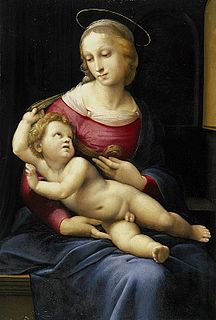
The Bridgewater Madonna is a religious painting by Raphael, dated 1507. Originally on oil and wood, but later transferred to canvas, it measures 81 by 55 cm. The picture is part of the permanent collection of the Scottish National Gallery in Edinburgh, on loan from the Duke of Sutherland Collection.
